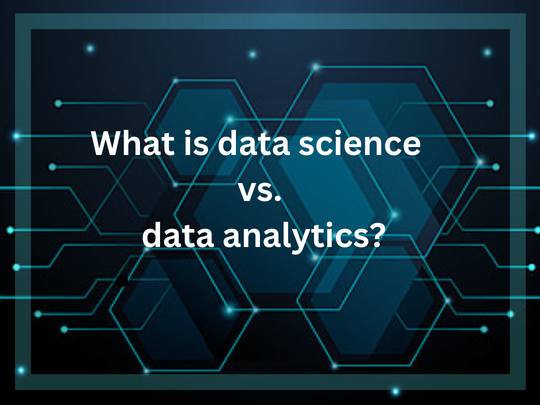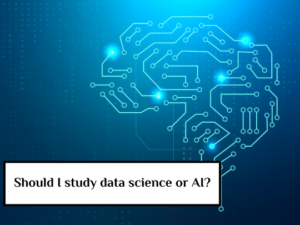Introduction
Data is the new oil in modern society, and the need for data specialists, specifically data analysts and data scientists, has grown dramatically. Unfortunately, the terms Data Analytics and Data Science are usually used together, leading to further confusion. Data Analysts and Data Scientists differ vastly in the ways in which they are employed and how they work.
Two of the most sought-after professional paths are data science and data analytics. Although the two areas are linked, they have separate responsibilities and requirements.
The key differences between data science and data analytics must be understood clearly. This article provides the necessary information to become a professional in either industry.
Read this article to learn the main distinctions between the two names and how their usage and skill sets vary.
Being a Data Scientist is just a step away. Check out the data science course fee in Pune at 360DigiTMG and get certified today.
Data Science and Data Analytics: an overview
Data Science and Data Analytics deal with data, but their approaches to gleaning insights from the data differ.
Data science includes deep knowledge and constant academic disciplines such as computer science, statistics, domain expertise, and mathematics.
To acquire useful insights from organized and unstructured data, sophisticated mathematical and statistical methodologies, algorithms, and machine learning techniques are employed.
Analyzing data to find trends, patterns, and insights that may be utilized to influence decisions is the emphasis of the discipline of data analytics. To glean insights from data, descriptive and diagnostic analytics are employed.
Diagnostic analytics is used to find the reason behind an event, whereas descriptive analytics is used to describe an event that is over.
Differences between Data Science and Data Analytics
Scope of Functioning:
Data analytics concentrates on deriving insights from structured data; hence, its use is limited. However, data science works with structured and unstructured data, offering a wider range of applications.
Tools and methods used by respective fields:
Excel, SAS, and R are the statistical analysis methods and tools frequently used in data analytics. In addition, machine learning techniques and computer languages like Python, R, and SAS are used in data science.
Objectives of the different fields:
Data science attempts to offer prescriptive and predictive insights to aid firms in innovating and streamlining their processes. On the other hand, data analytics offers descriptive insights that support companies in making wise decisions.
Data types the fields deal with:
Data science deals with structured and unstructured data, whereas data analytics only deals with structured data.
Now that we know the key differences let us try to understand the terms separately.
Data Science
Data science is an interdisciplinary field that combines computer science, statistics, and domain knowledge to get useful insights and feasible knowledge from data.
Data scientists utilize predictive analytics and machine learning algorithms to find patterns and insights in complicated and unstructured data. It involves performing analysis on both organized and unstructured data using programming languages.
Scientists deal with unorganized, unformatted data provided in its raw form. (eg. Social media data, sensor data, etc.). The data must be gathered, cleaned up, and prepared for analysis by data scientists.
Data scientists must be well-versed in analytical skills and programming languages and should possess a good understanding of business operations.
Other than the IT and Software industries, they work in other industries, including banking, healthcare, and e-commerce. They aid businesses in innovation, process improvement, and product and service enhancement.
Data Analytics
Analyzing data sets to draw conclusions about the information they contain is known as data analytics.
Data analysts employ statistical and quantitative analysis methods to spot patterns, connections, and trends in data. Data analytics aims to assist organizations in making defensible choices based on data-driven insights.
An excellent analyst should be skilled in statistical analysis software, possess strong analytical abilities, and have a solid grasp of business operations.
Data analysts use SAS, R, and Microsoft Excel to analyze structured data.
Data analysts work with data that has been organized in a specific way, like in a spreadsheet or database. Then, they handle data processing, cleaning, and modeling to extract valuable insights.
The IT and software industries majorly hire data analysts, but other industries like marketing, healthcare, retail, and financial industries are also looking for data analysts nowadays.
Data Analysts aid businesses in streamlining their processes, bettering their consumer comprehension, and optimizing marketing strategies.
Areas of Data Science and Data Analytics expertise
A wide range of programming, statistical, mathematical, and domain-specific skills are needed to become a good data scientist.
A good data scientist has a solid skill set that includes using programming languages like Python, R, and SQL like an expert and having a thorough understanding of mathematical ideas like calculus, linear algebra, probability, and statistics.
Deep learning, natural language processing, and machine learning techniques are further requirements.
Data analytics requires in-depth data handling, visualization, and statistical analysis knowledge.
Data analysts should be familiar with programs like Tableau and PowerBI for data visualization. Data analysts need to be proficient in addition to Python and R, regression analysis and hypothesis testing are two statistical methods.
Conclusion
Both data science and analytics are separate academic disciplines that need specialized knowledge and abilities.
Data science uses sophisticated mathematical, statistical, and machine learning approaches to mine organized and unstructured data for information and value.
Data analytics analyses data to discover trends, patterns, and insightful information that can be used to make wise decisions.
Both industries have a wealth of work opportunities and need distinct skill sets. While Data Analytics involves familiarity with data processing, visualization, and statistical analysis, Data Science necessitates a solid background in mathematics, programming, and domain expertise.
In conclusion, it is best to take on data science and analytics separately rather than combine them because they are independent disciplines with distinct roles and responsibilities.
If you want to transition or start a fresh career in data science or analytics, consider the differences mentioned in this article. They are completely different from each other in terms of the methodologies and concepts used.
Any industry in which you wish to begin a new or restored career requires that you be thoroughly knowledgeable about it.
Making an informed decision requires considering, processing, and analyzing the data, regardless of your current or future profession.
Browse Other Courses
- Artificial Intelligence Course in Pune
- Business Analytics Course in Pune
- Cloud Computing Course in pune
- Cyber Security Course in Pune
- Data Analytics Course in Pune
- Digital Marketing Course in pune
- Ethical Hacking Course in Pune
- IoT Certification Course Training in Pune
- Machine Learning Course in Pune
- PMP® Certificate Course in Pune
- Python Course in Pune
- Tableau Course in Pune
Navigate to Address:
360DigiTMG – Data Analytics, Data Science Course Training in Pune
No. 408, 4th Floor Saarrthi Success Square, near Maharshi Karve Statue, opp. Hotel Sheetal, Kothrud, Pune, Maharashtra 411038
089995 92875
Get Directions: Data Science Training




